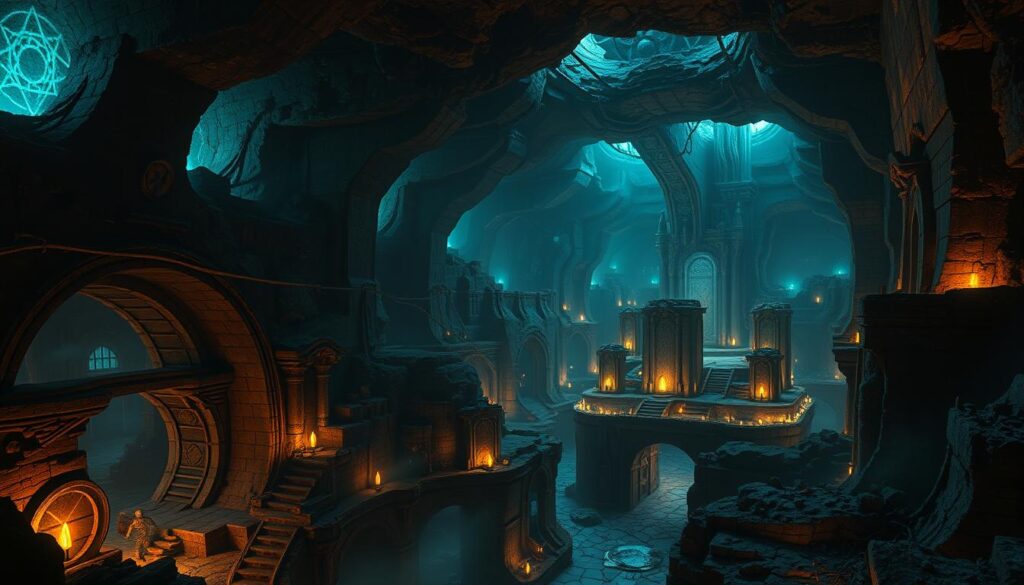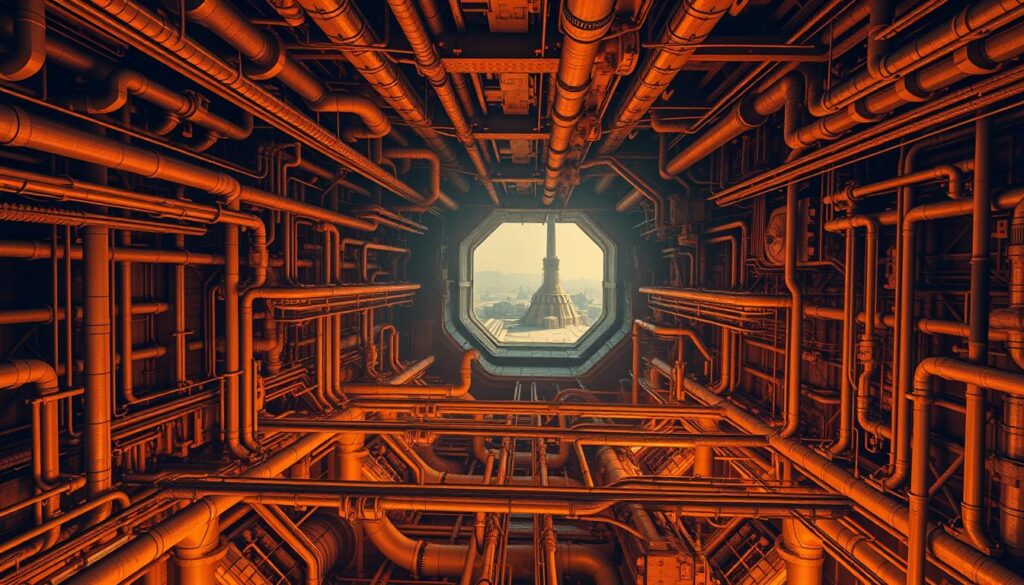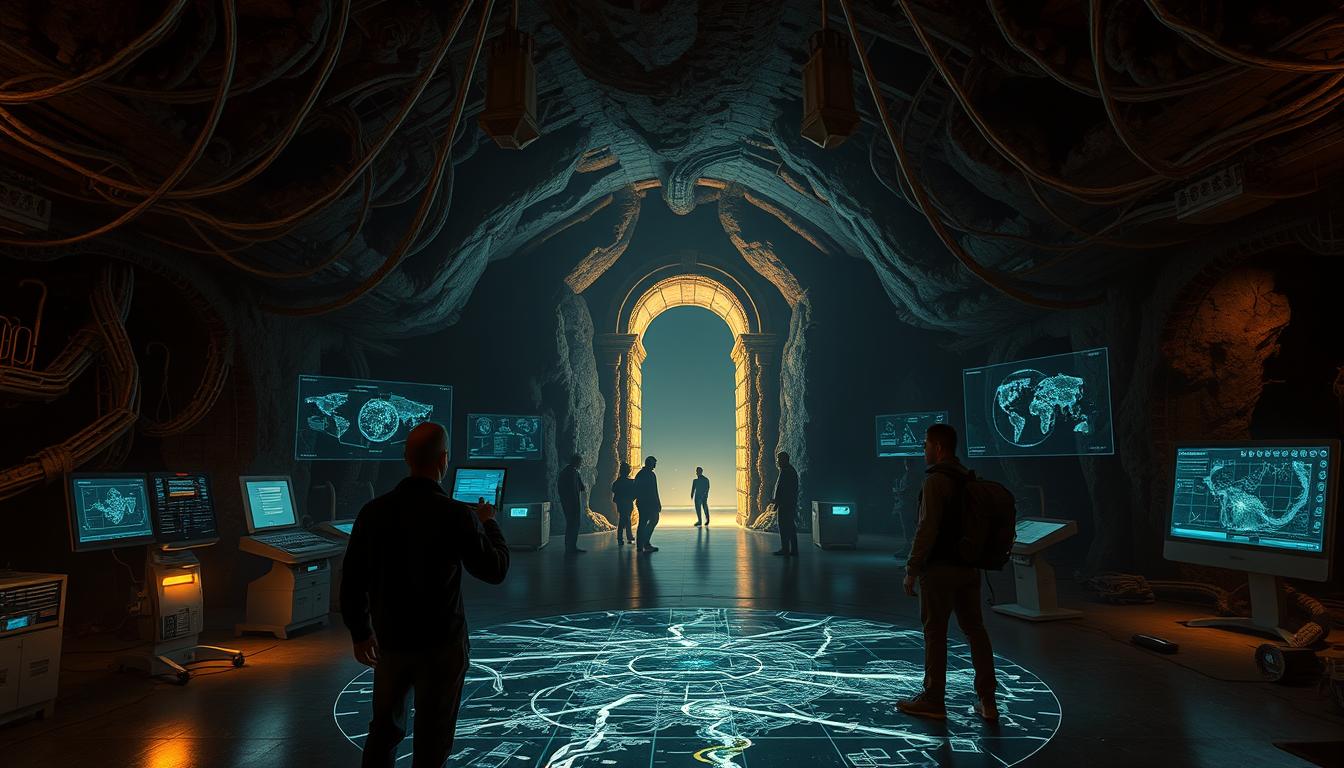Deep beneath our feet, worlds unseen might wait to be found. The idea of hidden underground civilizations has long fascinated explorers and dreamers. What if whole societies live below us, hidden from our everyday lives?

In places like Cappadocia, we find elaborate underground cities. Across continents, mysterious cave networks hint at human refuge below ground. These secrets challenge our views on history and how humans adapt.
Today, the quest for hidden underground worlds goes on. It mixes archaeological finds with old legends. Could vast tunnel systems link regions beneath us? Or might people have evolved to live without sunlight? These mysteries spark our curiosity about what lies in the dark below.
This exploration into Earth’s depths looks at both science and myths about underground societies. The truth might be even more intriguing than stories. We’ll see how such civilizations might work and why they stay hidden from us.
Key Takeaways
- Underground cities like those in Cappadocia show humans can build complex subterranean structures
- Ancient texts from different cultures talk about underground dwellers and hidden worlds
- Modern tech has uncovered unknown cave systems and tunnels
- Living underground poses unique challenges like air and food production
- The idea of undiscovered civilizations links science, mythology, and human creativity
- Archaeological finds are changing how we see underground living
The Fascination with Hidden Worlds Beneath Our Feet
The earth beneath our feet is full of secrets and mysteries. Our subterranean fascination has lasted for thousands of years. It crosses cultures and continents, sparking our deep curiosity.
Our interest in what lies beneath is more than just wonder. It’s about the allure of hidden civilizations and undiscovered wonders. From backyard explorers to cave scientists, we all want to uncover what’s hidden.
The underground represents our collective unconscious—a place where the impossible becomes possible, where ancient wisdom might be preserved, and where human imagination finds room to flourish in the darkness.
Stories of underground dwellers have captivated us for ages. They mix truth with fantasy, sparking our imagination. Our love for hidden underground worlds shows no signs of fading.
Unlike space, the world below is both close and mysterious. We’re just a few layers of rock away from discovering it. This close yet distant feeling fuels our subterranean fascination.
Ancient Texts and Legends of Subterranean Societies
Stories of underground worlds have been told for centuries. Hindu texts speak of Agartha, a place beneath Asia with advanced tech and wisdom. It’s said to be a paradise with millions living there, connected to the surface by tunnels in Tibet and India.
Greek myths also talk about underground realms, like Hades. The Hypogeum of Ħal-Saflieni in Malta has secrets that sparked local legends. People believed it was a place where underground dwellers communicated through echoes.
Native American tribes from the Grand Canyon have their own tales. They say their ancestors hid in caves. The Hopi believe in emerging from underground, and Tibetan texts talk about Shambhala, a kingdom of enlightened beings.
“The Smoky God,” a 1908 book by Willis George Emerson, claims to record the experiences of Olaf Jansen. He allegedly found a subterranean world at the North Pole, home to giants with advanced tech.
What’s fascinating about these legends is how similar they are. They come from different cultures and times but share common themes. They talk about advanced tech, special lighting, and unique societies. These stories keep sparking interest in hidden civilizations beneath us.
Archaeological Evidence Supporting Underground Habitation
The earth beneath our feet holds secrets of human ingenuity. Underground habitation evidence is found worldwide. It shows our ancestors built complex subterranean spaces for shelter and safety.
Derinkuyu and Other Cappadocian Underground Cities
Turkey’s Cappadocia is home to incredible underground dwellings. Derinkuyu underground city is a marvel, with eight levels 280 feet deep. It could hold up to 20,000 people, with animals, and had many features like ventilation and water wells.
Kaymakli and Özkonak are nearby, with their own underground wonders. They are connected by tunnels, protecting people for centuries.
Cave Dwellings Across Continents
Underground discoveries are found on every continent. They show how people adapted to living underground:
- China’s Loess Plateau yaodongs house millions even today
- Iran’s Kandovan village features cone-shaped dwellings carved from volcanic rock
- Spain’s Guadix region contains modern cave homes dating back centuries
- North America’s Ancestral Puebloan cliff dwellings at Mesa Verde
Recent Discoveries That Challenge Our Understanding
New excavations are changing what we know about underground living. In 2017, a hidden complex was found under Jerusalem, dating back to the Roman era. In Vietnam, tunnels from ancient times were mapped.
These discoveries make us wonder what else is hidden. The complexity of known structures suggests we’ve only scratched the surface of prehistoric underground life.
The Hypothetical Structure of an Undiscovered Underground Civilization
An advanced underground civilization would likely have a multi-tiered design. This design would make the most of limited space while meeting basic needs. The center might have governance and communal areas, acting as the heart of the subterranean city.
Residential areas would spread out from the center. They would have family units carved into rock walls. These units would have interconnected chambers of different sizes.
Water management is key in any underground society. Sophisticated aqueduct systems would bring groundwater to reservoirs. This would ensure a steady water supply.
Agricultural areas would use large caverns. Here, crops adapted to low light would grow. They would use terraced growing systems and hydroponics.
Air circulation is a big challenge for underground living. Ventilation shafts would connect to the surface. Additional technology would use natural air movement to keep air fresh and temperatures stable.
| Zone Type | Primary Function | Architectural Features |
|---|---|---|
| Central Hub | Governance & Social Gathering | Large open caverns, acoustic design, central water access |
| Residential Rings | Family Living & Personal Space | Modular chamber clusters, privacy partitions, storage alcoves |
| Agricultural Caverns | Food Production | Terraced growing beds, irrigation channels, light reflection systems |
| Transit Corridors | Movement & Transportation | Smoothed pathways, load-bearing supports, directional markers |
Security would be a big part of the underground civilization’s design. There would be few access points from the surface. These could be easily defended or hidden when needed.
Interior corridors would be wider for moving goods. They would also have support structures to keep the structure strong.
Environmental Challenges and Adaptations for Subterranean Living
Living underground comes with its own set of challenges. The tight spaces of underground areas pose big hurdles. Any civilization living here would need to find special ways to adapt.
Solving the Oxygen and Light Problem
Underground, there’s no natural air flow. This means complex systems are needed to bring in air. In Turkey, ancient cities used vertical shafts for air circulation.
Today, underground civilization adaptations might include artificial photosynthesis. This creates oxygen and light for people living below.
Food Sources and Sustainable Agriculture Below Ground
Without sunlight, farming as we know it is not possible. But, mushrooms can grow in dark, damp places. This makes them a good food source.
Hydroponics with artificial light could also grow many different crops. These underground environment solutions are key for food in subterranean societies.
Evolutionary Adaptations to Darkness
People living long-term underground would change physically. They might hear better, feel more, and move around in the dark more easily. Their skin would get lighter because of less UV light.
Their eyes could get bigger to catch what little light there is. This is similar to how cave animals have evolved over time.
Technology and Engineering Required for Large-Scale Underground Habitation
Building sustainable underground homes needs advanced engineering. The digging process requires special tools to cut through different types of rock. These tools must keep the structure strong.
Modern underground engineering uses strong support systems. These systems fight against pressure, moisture, and wear over time.

Managing water is a big challenge for underground living. Engineers must find ways to get clean water and keep it from flooding. They need systems that recycle water and drain excess moisture.
Keeping the air clean is also crucial. Underground homes need ventilation systems that bring in fresh air and remove bad gases. Some ideas include big vertical shafts or air purifiers using both mechanical and biological methods.
Generating energy underground offers new chances. Ideas include using geothermal energy, hydroelectric power from underground water, and bioluminescent lights. These could provide power without needing sunlight or surface resources.
Cultural and Social Aspects of Theoretical Underground Societies
Living underground creates unique cultures unlike anything above ground. These societies, without sunlight and surface resources, develop special ways to organize and express their identity.
Governance in Isolated Communities
Underground communities have strict systems due to limited resources. Leaders might be chosen for their practical skills, not charisma or wealth. Their rules focus on survival, like water and food management.
Space and resources lead to either close cooperation or strict hierarchies. Roles like engineers and farmers are crucial. They form the core of their society.
Art and Cultural Expression in Subterranean Environments
Art in underground societies adapts to their environment. Cave walls might be used as canvases, and sound arts thrive in echoes. Oral traditions keep history and values alive without materials.
In low light, touch-based art becomes key. Sculptures and textures become central to their culture.
The Psychology of Underground Living
Living underground changes psychology due to unique stressors. Darkness affects sleep and mood. The lack of seasons changes how they keep time and celebrate.
Close living spaces build strong bonds but can cause tension. People might develop better hearing and touch to cope with darkness. Their culture values cooperation, resource use, and adaptability for survival.
Modern Search Efforts and Scientific Perspectives on Underground Civilizations
The search for hidden underground civilizations is ongoing. New technology is changing how we explore beneath the earth. Ground-penetrating radar lets researchers see hundreds of feet underground without digging.
This tool maps cave systems and finds hollow spaces. These could be ancient living areas.

Satellite thermal imaging spots temperature changes that might mean underground structures. In Turkey, this tech found new parts of Cappadocia’s famous underground cities. Drones with sensors explore narrow passages, collecting data from hidden caverns.
Scientists have different views on underground societies. Geologists say air and structure problems make big underground places hard. But archaeologists think we don’t know enough about ancient engineering.
Dr. Sarah Miller leads searches in South America. She says, “We find new cave systems every month. It’s possible that whole networks of human homes are still undiscovered.” Some argue that while small underground places existed, big hidden civilizations are unlikely.
These searches mix science doubts with new ways to explore. Every find brings us closer to knowing if stories of huge underground worlds are true.
The Enduring Legacy of Underground Civilizations in Culture and Mystery
Underground civilizations have always fascinated us, crossing time and space. Classics like “Journey to the Center of the Earth” by Jules Verne have made us wonder about hidden societies. These stories have filled our books, movies, and TV shows, sparking our curiosity about what lies beneath.
Even with today’s technology, the mystery of underground civilizations remains. This gap between what we know and what we don’t fuels our fascination. It suggests that there are still many secrets waiting to be found.
Stories of underground civilizations, whether true or not, captivate us. They remind us that our world might be much bigger than we think. The underground civilization cultural impact, subterranean world legacy, and underground society influence keep inspiring us to explore the unknown.
FAQ
What are some of the historical accounts that fuel modern curiosity about underground civilizations?
Many cultures have shared stories of hidden worlds under the earth. For example, Hindu texts talk about Agartha, a place of advanced beings. Greek myths mention underworlds, and Native American legends tell of cave-dwelling ancestors. Tibetan stories also speak of underground kingdoms. These tales have sparked interest in the possibility of hidden societies.
What archaeological evidence supports the existence of underground habitation?
Archaeologists have found many underground homes built by humans. The Derinkuyu underground city in Turkey is a famous example. It has 18 levels and could hold thousands. Similar places exist worldwide, from China’s cave homes to America’s cliff dwellings.
What environmental challenges would an underground civilization need to overcome?
Living underground is hard due to air, light, and food issues. They’d need good air flow, light, and ways to grow food. They might also change over time, adapting to the dark.
What kind of technology and engineering would be required to maintain a large-scale underground civilization?
Building a big underground city would need advanced tools and systems. They’d need to manage water, waste, and energy. This could include new ways to dig, power, and support structures. It’s a big challenge, but possible for a highly advanced society.
How might the social and cultural aspects of an underground civilization differ from surface-based societies?
Life underground could shape their society and culture. They might focus more on survival and resource use. Their art and culture could be different, using senses like sound and touch. Living long-term underground could also change their values and worldview.
What are some of the modern search efforts and scientific perspectives on the possibility of undiscovered underground civilizations?
Today, scientists use radar, seismic imaging, and satellite maps to search for hidden cities. Some doubt the existence of large underground societies. Yet, others believe there’s still much to discover. The search and debate keep the mystery alive.
